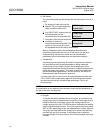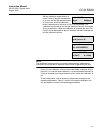
Instruction Manual
IM-106-5500, Original Issue
August 2005
3-11
CCO 5500
The transmissivity of a sample of any
gas depends both on the
concentration and on the path length
through which the radiation is
transmitted. Similarly, the output of the CCO 5500 monitor also
depends on the path length of the flue gas through which the
radiation is transmitted.
Refer to “Points to Consider” on page 2-4.
The Rosemount Analytical analyzers are sensitive to the product of
concentration x path length, and in order to obtain a true value of
concentration of gas, it is necessary to input the correct path length
into the processor. This value is then used to produce a final value of
gas concentration.
NOTE
The path length entered must represent the length of the actual gas pass, not
the flange-to-flange dimension between the transmitter and receiver.
d. Alarm
A contact output is available to warn of
a high gas concentration. This contact
output may be triggered from any of
the four averaging stacks. Select its
source with the ARROW key and enter it with the ENTER key.
Select the units for the alarm - these
may be different to the units selected
for the analog output.
After the source has been selected,
the instrument requires a level at
which the output will be triggered. Set
the desired level with the ARROW
keys.
e. Cal Factor
NOTE
Do not enter this mode without recording the original cal factor as displayed in
mode 4. The Cal factor will be lost when this menu option is entered.
During the calibration routine, the
instrument calculates a 'Cal Factor'
which sets the basic calibration of the
instrument. This value may be
changed from this mode.
5 PARAMETERS
Path length 0000mm
5 PARAMETERS
Alarm source 15m
5 PARAMETERS
Alarm mg/Nm3
5 PARAMETERS
Alarm 0000mg/Nm3
5 PARAMETERS
Cal Factor


















